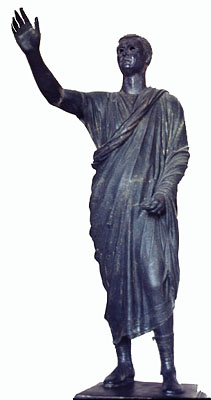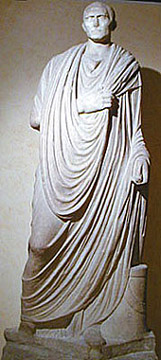

toga
The toga was the external civic garment of male citizens in peacetime, to be worn on all formal occasions, also by children of both sexes (see the Ara Pacis family relief and the statue of young Nero wearing the bulla). Made of wool and traditionally plain white, the toga was strictly forbidden to non-Romans and exiles. Although it was the field on which social and political status and special circumstances could be inscribed, plentiful texts reveal that it was a challenge to wear and to maintain: Umbricius confesses that his toga is sordidula and Martial complains that in Rome he wears out four a year (Epigrammata 10.96.11).
Throughout the ancient world the toga was the unique, recognized emblem of Roman citizenship, its wearers the gens togata (see Vergil, Aeneid 1.282 and Martial Epigrammata 14.124), even, Umbricius testifies, when they are dead. Two familiar sculptures demonstrate the elaboration of the toga in size and method of draping from the Republic to the early Empire.
| L'Arringatore (1st Century BCE) | Orator, 1st Century CE |
 |
 |